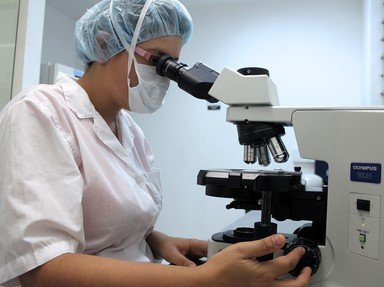Quiz Answer Key and Fun Facts
1. One of the most essential processes in cell maintenance is the ability to degrade proteins that are old or damaged. The inability to do this contributes to several disorders such as Alzheimer's and diabetes. Which small protein, named for its abundance, is attached to proteins to "mark them for destruction"?
2. In order to prevent excessive blood loss from our bodies, certain residues of important protein factors involved in coagulation need to be modified by the addition of carboxyl groups. This carboxylation is dependent on another factor which is abundant in green leafy vegetables. What is the name of this factor?
3. Post-translational modification is also important for the functionality of the most abundant protein in our body. This protein contains many proline residues, some of which are hydroxylated. This modification is necessary for the formation of the triple helix which allows this protein to carry out its function in the skin, bone, and cartilage. What is the name of this protein?
4. Post-translational modification is also essential for controlling which cells express which genes. Acetyl groups can be added to the proteins which bind to DNA, inducing nearby genes to be expressed. What name is given to these DNA-associated proteins which help to regulate gene expression?
5. Another post-translational modification involved in gene regulation is the addition of -CH3 groups. The importance of maintaining correct levels of this modification has been highlighted by the fact that imbalances are commonly implicated with contributing to cancer. What is the term for this modification?
6. A case could be made for phosphorylation being the most important protein modification in our bodies, simply due to the sheer number of jobs it carries out. These jobs include stabilising/destabilising proteins, activating/inactivating enzymes and transcription factors, and the transmission of signals from outside the cell to inside. What name is given to the group of enzymes which perform phosphorylation and therefore regulate these essential processes?
7. Addition of sugars and carbohydrates to proteins mainly plays a protective role in the body, but can also be important in signalling, stability and protein trafficking. What term is used for this type of modification?
8. The shape of a protein is key to its function. In order to achieve this shape, the protein must fold, and this is assisted by yet another post-translational modification. Specifically, this involves the formation of covalent bonds between sulphur atoms found on specific amino acids in the protein. What are these interactions more commonly known as?
9. A process known as prenylation involves the attachment of hydrophobic groups to proteins. One such protein is Ras, which is a central player in the transmission of outside signals into the cell. With this in mind, by which cellular component does prenylation often localise Ras to?
10. Proteins may be prevented from being properly modified until they reach their appropriate location. One such example is proteolytic enzymes. These proteins exist in inactive states until they are cleaved upon reaching their correct compartment. What term is given to the inactive states of proteases prior to activation?
Source: Author
doublemm
This quiz was reviewed by FunTrivia editor
CellarDoor before going online.
Any errors found in FunTrivia content are routinely corrected through our feedback system.

